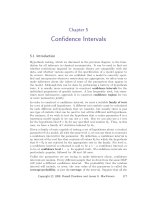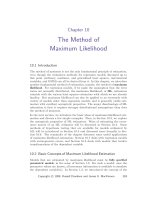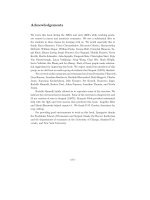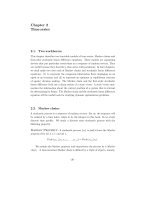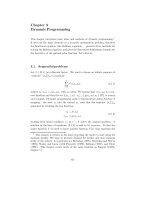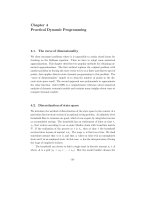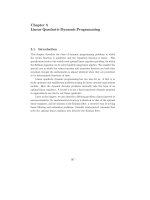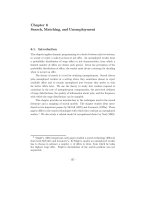Recursive macroeconomic theory, Thomas Sargent 2nd Ed - Chapter 16 pps
Bạn đang xem bản rút gọn của tài liệu. Xem và tải ngay bản đầy đủ của tài liệu tại đây (198.33 KB, 22 trang )
Part IV
The savings problem and Bewley mod-
els
Chapter 16
Self-Insurance
16.1. Introduction
This chapter describes a version of what is sometimes called a savings problem
(e.g., Chamberlain and Wilson, 2000). A consumer wants to maximize the
expected discounted sum of a concave function of one-period consumption rates,
as in chapter 8. However, the consumer is cut off from all insurance markets and
almost all asset markets. The consumer can only purchase nonnegative amounts
of a single risk-free asset. The absence of insurance opportunities induces the
consumer to adjust his asset holdings to acquire “self-insurance.”
This model is interesting to us partly as a benchmark to compare with the
complete markets model of chapter 8 and some of the recursive contracts models
of chapter 19, where information and enforcement problems restrict allocations
relative to chapter 8, but nevertheless permit more insurance than is allowed in
this chapter. A generalization of the single-agent model of this chapter will also
be an important component of the incomplete markets models of chapter 17.
Finally, the chapter provides our first brush with the powerful supermartingale
convergence theorem.
To highlight the effects of uncertainty and borrowing constraints, we shall
study versions of the savings problem under alternative assumptions about
the stringency of the borrowing constraint and alternative assumptions about
whether the household’s endowment stream is known or uncertain.
– 540 –
The consumer’s environment 541
16.2. The consumer’s environment
An agent orders consumption streams according to
E
0
∞
t=0
β
t
u (c
t
) , (16.2.1)
where β ∈ (0, 1), and u(c) is a strictly increasing, strictly concave, twice con-
tinuously differentiable function of the consumption of a single good c.The
agent is endowed with an infinite random sequence {y
t
}
∞
t=0
of the good. Each
period, the endowment takes one of a finite number of values, indexed by s ∈ S.
In particular, the set of possible endowments is
y
1
< y
2
< ··· < y
S
.Elements
of the sequence of endowments are independently and identically distributed
with Prob(y =
y
s
)=Π
s
, Π
s
≥ 0, and
s∈S
Π
s
= 1. There are no insurance
markets.
The agent can hold nonnegative amounts of a single risk-free asset that has
a net rate of return r where (1+r)β =1. Leta
t
≥ 0 be the agent’s assets at the
beginning of period t including the current realization of the income process.
(Later we shall use an alternative and common notation by defining b
t
= −a
t
+y
t
as the debt of the consumer at the beginning of period t, excluding the time
t endowment.) We assume that a
0
= y
0
is drawn from the time invariant
endowment distribution {Π
s
}. (This is equivalent to assuming that b
0
=0 in
the alternative notation.) The agent faces the sequence of budget constraints
a
t+1
=(1+r)(a
t
− c
t
)+y
t+1
, (16.2.2)
where 0 ≤ c
t
≤ a
t
,witha
0
given. That c
t
≤ a
t
is the constraint that holdings
of the asset at the end of the period (which evidently equal
a
t+1
−y
t+1
1+r
)mustbe
nonnegative. The constraint c
t
≥ 0 is either imposed or comes from an Inada
condition lim
c↓0
u
(c)=+∞.
The Bellman equation for an agent with a>0is
V (a)=max
c
u(c)+
S
s=1
β Π
s
V
(1 + r)(a −c)+y
s
(16.2.3)
subject to 0 ≤ c ≤ a,
where y
s
is the income realization in state s ∈ S. The value function V (a)
inherits the basic properties of u(c); that is, V (y) is increasing, strictly concave,
and differentiable.
542 Self-Insurance
“Self-insurance” occurs when the agent uses savings to insure himself against
income fluctuations. On the one hand, in response to low income realizations,
an agent can draw down his savings and avoid temporary large drops in con-
sumption. On the other hand, the agent can partly save high income realizations
in anticipation of poor outcomes in the future. We are interested in the long-
run properties of an optimal “self-insurance” scheme. Will the agent’s future
consumption settle down around some level ¯c?
1
Or will the agent eventually be-
come impoverished?
2
Following the analysis of Chamberlain and Wilson (2000)
and Sotomayor (1984), we will show that neither of these outcomes occurs:
consumption will diverge to infinity!
Before analyzing it under uncertainty, we’ll briefly consider the savings
problem under a certain endowment sequence. With a non-random endowment
that does not grow perpetually, consumption does converge.
16.3. Nonstochastic endowment
Without uncertainty the question of insurance is moot. However, it is instruc-
tive to study the optimal consumption decisions of an agent with an uneven
income stream who faces a borrowing constraint. We break our analysis of the
nonstochastic case into two parts, depending on the stringency of the borrow-
ing constraint. We begin with the least stringent possible borrowing constraint,
namely, the natural borrowing constraint on one-period Arrow securities, which
are risk-free in the current context. After that, we’ll arbitraily tighten the bor-
rowing constraint to arrive at the no-borrowing condition a
t+1
≥ y
t+1
imposed
in the statement of the problem in the previous section.
For convenience, we temporarily use our alternative notation. We let b
t
be
the amount of one-period debt that the consumer owes at time t; b
t
is related
to a
t
by
a
t
= −b
t
+ y
t
,
1
As will occur in the model of social insurance without commitment, to be
analyzed in chapter 19.
2
As in the case of social insurance with asymmetric information, to be ana-
lyzed in chapter 19.
Nonstochastic endowment 543
with b
0
=0. Here −b
t
is the consumer’s asset position before the realization of
his time t endowment. In this notation, the time t budget constraint (16.2.2)
becomes
c
t
+ b
t
≤ βb
t+1
+ y
t
(16.3.1)
where in terms of b
t+1
, we would express a no-borrowing constraint (a
t+1
≥
y
t+1
)as
b
t+1
≤ 0. (16.3.2)
The no-borrowing constraint (16.3.2) is evidently more stringent than the
natural borrowing constraint on one-period Arrow securities that we imposed
in chapter 8. Under an Inada condition on u(c)atc = 0, or alternatively when
c
t
≥ 0 is imposed, the natural borrowing constraint in this non-stochastic case
is found by solving (16.3.1) forward with c
t
≡ 0:
b
t
≤
∞
j=0
β
j
y
t+j
≡ b
t
. (16.3.3)
The right side is the maximal amount that it is feasible to pay repay at time t
when c
t
≥ 0.
Solve (16.3.1) forward and impose the initial condition b
0
=0 toget
∞
t=0
β
t
c
t
≤
∞
t=0
β
t
y
t
. (16.3.4)
When c
t
≥ 0, under the natural borrowing constraints, this is the only restric-
tion that the budget constraints (16.3.1) impose on the {c
t
} sequence. The
first-order conditions for maximizing (16.2.1) subject to (16.3.2) are
u
(c
t
) ≥ u
(c
t+1
) , =ifb
t+1
< b
t+1
. (16.3.5)
It is possible to satisfy these first-order conditions by setting c
t
= c for all t ≥ 0,
where
c is the constant consumption level chosen to satisfy (16.3.4) at equality:
c
1 − β
=
∞
t=0
β
t
y
t+j
. (16.3.6)
Under this policy, b
t
is given by
b
t
= β
−t
t−1
j=0
β
j
(c − y
j
)=β
−t
c
1 − β
−
β
t
c
1 − β
−
t−1
j=0
β
j
y
j
=
∞
j=0
β
j
y
t+j
−
c
1 − β
544 Self-Insurance
where the last equality invokes (16.3.6). This expression for b
t
is evidently less
than or equal to
b
t
for all t ≥ 0. Thus, under the natural borrowing constraints,
we have constant consumption for t ≥ 0, i.e., perfect consumption smoothing
over time.
The natural debt limits allow b
t
to be positive, provided that it is not
too large. Next we shall study the more severe ad hoc debt limit that requires
−b
t
≥ 0, so that the consumer can lend, but not borrow. This restriction will
inhibit consumption smoothing for households whose incomes are growing, and
who therefore are naturally borrowers.
3
16.3.1. An ad hoc borrowing constraint: non-negative assets
We continue to assume a known endowment sequence but now impose a no-
borrowing constraint (1 + r)
−1
b
t+1
≤ 0 ∀t ≥ 0. To facilitate the transition to
our subsequent analysis of the problem under uncertainty, we work in terms of a
definition of assets that include this period’s income, a
t
= −b
t
+y
t
.
4
Let (c
∗
t
,a
∗
t
)
denote an optimal path. First order necessary conditions for an optimum are
u
(c
∗
t
) ≥ u
c
∗
t+1
, =ifc
∗
t
<a
∗
t
(16.3.7)
for t ≥ 0. Along an optimal path, it must be true that either
(a) c
∗
t−1
= c
∗
t
;or
(b) c
∗
t−1
<c
∗
t
and c
∗
t−1
= a
∗
t−1
, and hence a
∗
t
= y
t
.
Condition (b) states that the no-borrowing constraint binds only when the con-
sumer desires to shift consumption from the future to the present. He will desire
to do that only when his endowment is growing.
According to conditions (a) and (b), c
t−1
can never exceed c
t
. The reason
is that a declining consumption sequence can be improved by cutting a marginal
unit of consumption at time t −1 with a utility loss of u
(c
t−1
) and increasing
3
See exercise 16.1 for how income growth and shrinkage impinge on con-
sumption in the presence of an ad hoc borrowing constraint.
4
When {y
t
} is an i.i.d. process, working with a
t
rather than b
t
makes it
possible to formulate the consumer’s Bellman equation in terms of the single
state variable a
t
, rather than the pair b
t
,y
t
. We’ll exploit this idea again in
chapter 17.
Nonstochastic endowment 545
consumption at time t by the saving plus interest with a discounted utility gain
of β(1+r)u
(c
t
)=u
(c
t
) >u
(c
t−1
), where the inequality follows from the strict
concavity of u(c)andc
t−1
>c
t
. A symmetrical argument rules out c
t−1
<c
t
as
long as the nonnegativity constraint on savings is not binding; that is, an agent
would choose to cut his savings to make c
t−1
equal to c
t
as in condition (a).
Therefore, consumption increases from one period to another as in condition (b)
only for a constrained agent with zero savings, a
∗
t−1
−c
∗
t−1
= 0. It follows that
next period’s assets are then equal to next period’s income, a
∗
t
= y
t
.
Solving the budget constraint (16.2.2) at equality forward for a
t
and rear-
ranging gives
∞
j=0
β
j
c
t+j
= a
t
+ β
∞
j=1
β
j
y
t+j
. (16.3.8)
At dates t ≥ 1forwhicha
t
= y
t
, so that the no-borrowing constraint was
binding at time t − 1, (16.3.8) becomes
∞
j=0
β
j
c
t+j
=
∞
j=0
β
j
y
t+j
. (16.3.9)
Equations (16.3.8) and (16.3.9) contain important information about the opti-
mal solution. Equation (16.3.8) holds for all dates t ≥ 1atwhichtheconsumer
arrives with positive net assets a
t
− y
t
> 0. Equation (16.3.9) holds for those
dates t at which net assets or savings a
t
−y
t
are zero, i.e., when the no-borrowing
constraint was binding at t − 1. If the no-borrowing constraint is binding only
finitely often, then after the last date
t−1 at which it was binding, (16.3.9) and
the Euler equation (16.3.7) imply that consumption will thereafter be constant
at a rate ˜c that satisfies
˜c
1−β
=
∞
j=0
β
j
y
t+j
.
In more detail, suppose that an agent arrives in period t with zero savings
and that he knows that the borrowing constraint will never bind again. He would
then find it optimal to choose the highest sustainable constant consumption.
This is given by the annuity value of the tail of the income process starting from
period t,
x
t
≡
r
1+r
∞
j=t
(1 + r)
t−j
y
j
. (16.3.10)
In the optimization problem under certainty, the impact of the borrowing con-
straint will not vanish until the date at which the annuity value of the tail (or
546 Self-Insurance
remainder) of the income process is maximized. We state this in the following
proposition.
Proposition 1: Given a borrowing constraint and a nonstochastic endow-
ment stream, the limit of the nondecreasing optimal consumption path is
¯c ≡ lim
t→∞
c
∗
t
=sup
t
x
t
≡ ¯x. (16.3.11)
Proof: We will first show that ¯c ≤ ¯x. Suppose to the contrary that ¯c>¯x.
Then conditions (a) and (b) imply that there is a t such that a
∗
t
= y
t
and
c
∗
j
>x
t
for all j ≥ t. Therefore, there is a τ sufficiently large that
0 <
τ
j=t
(1 + r)
t−j
c
∗
j
− y
j
=(1+r)
t−τ
c
∗
τ
− a
∗
τ
,
where the equality uses a
∗
t
= y
t
and successive iterations on budget constraint
(16.2.2). The implication that c
∗
τ
>a
∗
τ
constitutes a contradiction because it
violates the constraint that savings are nonnegative in optimization problem
(16.2.3).
To show that ¯c ≥ ¯x, suppose to the contrary that ¯c<¯x. Then there is an
x
t
such that c
∗
j
<x
t
for all j ≥ t, and hence
∞
j=t
(1 + r)
t−j
c
∗
j
<
∞
j=t
(1 + r)
t−j
x
t
=
∞
j=t
(1 + r)
t−j
y
j
≤ a
∗
t
+
∞
j=t+1
(1 + r)
t−j
y
j
,
where the last weak inequality uses a
∗
t
≥ y
t
. Therefore, there is an >0and
ˆτ>tsuch that for all τ>ˆτ ,
τ
j=t
(1 + r)
t−j
c
∗
j
<a
∗
t
+
τ
j=t+1
(1 + r)
t−j
y
j
− ,
and after invoking budget constraint (16.2.2) repeatedly,
(1 + r)
t−τ
c
∗
τ
< (1 + r)
t−τ
a
∗
τ
− ,
Nonstochastic endowment 547
or, equivalently,
c
∗
τ
<a
∗
τ
− (1 + r)
τ −t
.
We can then construct an alternative feasible consumption sequence {c
j
} such
that c
j
= c
∗
j
for j =ˆτ and c
j
= c
∗
j
+ for j =ˆτ . The fact that this alternative
sequence yields higher utility establishes the contradiction.
More generally, we know that at each date t ≥ 1 for which the no-borrowing
constraint is binding at date t−1, consumption will increase to satisfy (16.3.9).
The time series of consumption will thus be a discrete time ‘step function’ whose
jump dates
t coincide with the dates at which x
t
attains new highs:
t = {t : x
t
>x
s
,s<t}.
If there is a finite last date
t, optimal consumption is a monotone bounded
sequence that converges to a finite limit.
In summary, we have shown that under certainty the optimal consumption
sequence converges to a finite limit as long as the discounted value of future
income is bounded. Surprisingly enough, that result is overturned when there is
uncertainty. But first, consider a simple example of a nonstochastic endowment
process.
16.3.2. Example: Periodic endowment process
Suppose that the endowment oscillates between one good in even periods and
zero goods in odd periods. The annuity value of this endowment process is equal
to
x
t
t even
=
r
1+r
∞
j=0
(1 + r)
−2j
=(1−β)
∞
j=0
β
2j
=
1
1+β
, (16.3.12a)
x
t
t odd
=
1
1+r
x
t
t even
=
β
1+β
. (16.3.12b)
According to Proposition 1, the limit of the optimal consumption path is then
¯c =(1+β)
−1
. That is, as soon as the agent reaches the first even period in life,
he sets consumption equal to ¯c forevermore. The associated beginning-of-period
assets a
t
fluctuates between (1 + β)
−1
and 1.
The exercises at the end of this chapter contain more examples.
548 Self-Insurance
16.4. Quadratic preferences
It is useful briefly to consider the linear-quadratic permanent income model as
a benchmark for the results to come. Assume as before that β(1 + r)=1
and that the household’s budget constraint at t is (16.3.1). Rather than the
no-borrowing constraint (16.3.2), we impose that
5
E
0
lim
t→∞
β
t
b
2
t
=0. (16.4.1)
This constrains the asymptotic rate at which debt can grow. Subject to this
constraint, solving (16.3.1) forward yields
b
t
=
∞
j=0
β
j
(y
t+j
− c
t+j
) . (16.4.2)
We alter the preference specification above to make u(c
t
) a quadratic func-
tion −.5(c
t
−γ)
2
,whereγ>0 is a ‘bliss’ consumption level. Marginal utility is
linear in consumption: u
(c)=γ −c. We put no bounds on c;inparticular,we
allow consumption to be negative. We allow {y
t
} to be an arbitrary stationary
stochastic process.
The weakness of constraint (16.4.1) allows the houshold’s first-order con-
dition to prevail with equality at all t ≥ 0: u
(c
t
)=E
t
u
(c
t+1
). The linearity
of marginal utility in turn implies
E
t
c
t+1
= c
t
, (16.4.3)
which states that c
t
is a martingale. Combining (16.4.3) with (16.4.2) and tak-
ing expectations conditional on time t information gives b
t
= E
t
∞
j=0
β
j
y
t+j
−
1
1−β
c
t
or
c
t
=
r
1+r
−b
t
+ E
t
∞
j=0
1
1+r
j
y
t+j
. (16.4.4)
5
The natural borrowing limit assumes that consumption is nonnegative,
while the model with quadratic preferences permits consumption to be nega-
tive. When consumption can be negative, there seems to be no natural lower
bound to the amount of debt that could be repaid, since more payments can
always be wrung out of the consumer. Thus, with quadratic preferences we have
to rethink the sense of a borrowing constraint. The alternative (16.4.1) allows
negative consumption but limits the rate at which debt is allowed to grow in a
way designed to rule out a Ponzi-scheme that would have the consumer always
consume bliss consumption by accumulating debt without limit.
Stochastic endowment process: i.i.d. case 549
Equation (16.4.4) is a version of the permanent income hypothesis and tells the
consumer to set his current consumption equal to the annuity value of his non-
human (−b
t
) and ‘human’ (E
t
∞
j=0
1
1+r
j
y
t+j
) wealth. We can substitute
this consumption rule into (16.3.1) and rearrange to get
b
t+1
= b
t
+ rE
t
∞
j=0
1
1+r
j
y
t+j
− (1 + r) y
t
. (16.4.5)
Equations (16.4.4), (16.4.5) imply that under the optimal policy, c
t
,b
t
both
have unit roots and that they are ‘cointegrated’.
Consumption rule (16.4.4) has the remarkable feature of certainty equiv-
alence: consumption c
t
depends only on the first moment of the discounted
value of the endowment sequence. In particular, the conditional variance of the
present value of the endowment does not matter.
6
Under rule (16.4.4), con-
sumption is a martingale and the consumer’s assets b
t
are a unit root process.
Neither consumption nor assets converge, though at each point in time, the
consumer expects his consumption not to drift in its average value.
The next section shows that these outcomes will change dramatically when
we alter the specification of the utility function to rule out negative consumption.
16.5. Stochastic endowment process: i.i.d. case
With uncertain endowments, the first-order condition for the optimization prob-
lem (16.2.3) is
u
(c) ≥
S
s=1
β(1 + r)Π
s
V
(1 + r)(a −c)+y
s
, (16.5.1)
with equality if the nonnegativity constraint on savings is not binding. The
Benveniste-Scheinkman formula implies u
(c)=V
(a), so the first-order condi-
tion can also be written as
V
(a) ≥
S
s=1
β (1 + r)Π
s
V
(a
s
) , (16.5.2)
6
This property of the consumption rule reflects the workings of the type of
certainty equivalence that we discussed in chapter 5.
550 Self-Insurance
where a
s
is next period’s assets if the income shock is y
s
.Sinceβ
−1
=(1+r),
V
(a) is a nonnegative supermartingale. By a theorem of Doob (1953, p. 324),
7
V
(a) must then converge almost surely. The limiting value of V
(a)mustbe
zero based on the following argument: Suppose to the contrary that V
(a)
converges to a strictly positive limit. That supposition implies that a converges
to a finite positive value. But this implication is immediately contradicted by the
nature of the optimal policy function, which makes c a function of a, together
with the budget constraint (16.2.2): randomness of y
s
contradicts a finite limit
for a.Instead,V
(a) must converge to zero, implying that assets diverge to
infinity. (We return to this result in chapter 17 on incomplete market models.)
Though assets diverge to infinity, they do not increase monotonically. Since
assets are used for self-insurance, we would expect that low income realizations
are associated with reductions in assets. To show this point, suppose to the con-
trary that even the lowest income realization y
1
is associated with nondecreasing
assets; that is, (1 + r)(a − c)+y
1
≥ a.Thenwehave
V
(1 + r)(a −c)+y
1
≤ V
(a)
=
S
s=1
Π
s
V
(1 + r)(a −c)+y
s
, (16.5.3)
where the last equality is first-order condition (16.5.2) when the nonnegativity
constraint on savings is not binding and after using β
−1
=(1+r). Since
V
[(1 + r)(a −c)+y
s
] ≤ V
[(1 + r)(a −c)+y
1
] for all s ∈ S, expression (16.5.3)
implies that the derivatives of V evaluated at different asset values are equal to
each other, an implication that is contradicted by the strict concavity of V .
The fact that assets converge to infinity means that the individual’s con-
sumption also converges to infinity. After invoking the Benveniste-Scheinkman
formula, first-order condition (16.5.1) can be rewritten as
u
(c) ≥
S
s=1
β (1 + r)Π
s
u
(c
s
)=
S
s=1
Π
s
u
(c
s
) , (16.5.4)
where c
s
is next period’s consumption if the income shock is y
s
,andthelast
equality uses (1 + r)=β
−1
. It is important to recognize that the individual
will never find it optimal to choose a time-invariant consumption level for the
7
See the appendix of this chapter for a statement of the theorem.
Stochastic endowment process: general case 551
indefinite future. Suppose to the contrary that the individual at time t were to
choose a constant consumption level for all future periods. The maximum con-
stant consumption level that would be sustainable under all conceivable future
income realizations is the annuity value of his current assets a
t
and a stream of
future incomes all equal to the lowest income realization. But whenever there is
a future period with a higher income realization, we can use an argument similar
to our earlier construction of the sequence {c
j
} in the case of certainty to show
that the initial time-invariant consumption level does not maximize the agent’s
utility. It follows that future consumption will vary with income realizations and
consumption cannot converge to a finite limit with an i.i.d. endowment process.
Hence, when applying the martingale convergence theorem, the nonnegative su-
permartingale u
(c)in(16.5.4) must converge to zero since any strictly positive
limit would imply that consumption converges to a finite limit, which is ruled
out.
16.6. Stochastic endowment process: general case
The result that consumption diverges to infinity with an i.i.d. endowment pro-
cess is extended by Chamberlain and Wilson (2000) to an arbitrary stationary
stochastic endowment process that is sufficiently stochastic. Let I
t
denote the
information set at time t. Then the general version of first-order condition
(16.5.4) becomes
u
(c
t
) ≥ E
u
(c
t+1
)
I
t
, (16.6.1)
where E(·|I
t
) is the expectation operator conditioned upon information set I
t
.
Assuming a bounded utility function, Chamberlain and Wilson prove the fol-
lowing result, where x
t
is defined in (16.3.10):
Proposition 2: If there is an >0 such that for any α ∈
P
α ≤ x
t
≤ α +
I
t
< 1 −
for all I
t
and t ≥ 0, then P (lim
t→∞
c
t
= ∞)=1.
Without providing a proof here, it is useful to make a connection to the
nonstochastic case in Proposition 1. Under certainty, the limiting value of the
552 Self-Insurance
consumption path is given by the highest annuity of the endowment process
across all starting dates t;¯c =sup
t
x
t
. Under uncertainty, Proposition 2 says
that the consumption path will never converge to any finite limit if the annuity
value of the endowment process is sufficiently stochastic. Instead, the optimal
consumption path will then converge to infinity. This stark difference between
the case of certainty and uncertainty is quite remarkable.
8
16.7. Economic intuition
Imagine that you perturb any constant endowment stream by adding the slight-
est i.i.d. component. Our two propositions then say that the optimal consump-
tion path changes from being a constant to becoming a stochastic process that
goes to infinity. Beyond appealing to martingale convergence theorems, Cham-
berlain and Wilson (2000, p. 381) comment upon the difficulty of developing
economic intuition for this startling finding:
Unfortunately, the line of argument used in the proof does not provide
a very convincing economic explanation. Clearly the strict concavity
of the utility function must play a role. (The result does not hold if,
for instance, u is a linear function over a sufficiently large domain and
(x
t
) is bounded.) But to simply attribute the result to risk aversion on
the grounds that uncertain future returns will cause risk-averse con-
sumers to save more, given any initial asset level, is not a completely
satisfactory explanation either. In fact, it is a bit misleading. First,
that argument only explains why expected accumulated assets would
tend to be larger in the limit. It does not really explain why consump-
tion should grow without bound. Second, over any finite time horizon,
the argument is not even necessarily correct.
Given a finite horizon, Chamberlain and Wilson proceed to discuss how mean-
preserving spreads of future income leave current consumption unaffected when
the agent’s utility function is quadratic over a sufficiently large domain.
8
In exercise 16.3, you will be asked to prove that the divergence of consump-
tion to +∞ also occurs under a stochastic counterpart to the natural borrowing
limits. These are less stringent than the no-borrowing condition.
Economic intuition 553
We believe that the economic intuition is to be found in the strict concavity
of the utility function and the assumption that the marginal utility of consump-
tion must remain positive for any arbitrarily high consumption level. This rules
out quadratic utility, for example. To advance this explanation, we first focus
on utility functions whose marginal utility of consumption is strictly convex,
i.e., u
> 0 if the function is thrice differentiable. Then, Jensen’s inequality
implies
s
Π
s
u
(c
s
) >u
(
s
Π
s
c
s
); first-order condition (16.5.4) then implies
c<
S
s=1
Π
s
c
s
, (16.7.1)
where the strict inequality follows from our earlier argument that future con-
sumption levels will not be constant but will vary with income realizations. In
other words, when the marginal utility of consumption is strictly convex, a given
absolute decline in consumption is not only more costly in utility than a gain
from an identical absolute increase in consumption, but the former is also asso-
ciated with a larger rise in marginal utility as compared to the drop in marginal
utility of the latter. To set today’s marginal utility of consumption equal to next
period’s expected marginal utility of consumption, the consumer must therefore
balance future states with expected declines in consumption against appropri-
ately higher expected increases in consumption for other states. Of course, when
next period arrives and the consumer chooses optimal consumption optimal con-
sumption then (which is on average higher than last period’s consumption), the
same argument applies again. That is, the process exhibits a “ratchet effect” by
which consumption tends toward ever higher levels. Moreover, this on-average
increasing consumption sequence cannot converge to a finite limit because of our
earlier argument based on an agent’s desire to exhaust all his resources while
respecting his budget constraint.
Strictly speaking, this argument for the optimality of unbounded consump-
tion growth applies to utility functions whose marginal utility of consumption
is strictly convex. But even utility functions that do not have convex marginal
utility globally must ultimately conform to a similar condition over long enough
intervals of the positive real line, because otherwise those utility functions would
eventually violate the assumptions of a strictly positive, strictly diminishing
marginal utility of consumption, u
> 0andu
< 0. Chamberlain and Wil-
son’s reference to a quadratic utility function illustrates the problem of how the
554 Self-Insurance
marginal utility of consumption will otherwise turn negative at large consump-
tion levels. Thus, our understanding of the remarkable result in Proposition 2
is aided by considering the inevitable ratchet effect upon consumption implied
by the first-order condition for the agent’s optimal intertemporal choice.
16.8. Concluding remarks
This chapter has maintained the assumption that β(1 + r)=1,whichisavery
important ingredient in delivering the divergence toward infinity of the agent’s
asset and consumption level. Chamberlain and Wilson (1984) study a much
more general version of the model where they relax this condition.
Chapter 17 will put together continua of agents facing generalizations of the
savings problems in order to build some incomplete markets models. The models
of that chapter will determine the interest rate 1 + r as an equilibrium object.
In these models, to define a stationary equilibrium, we want the sequence of
distributions of each agent’s asset holdings to converge to a well defined invariant
distribution with finite first and second moments. For there to exist a stationary
equilibrium without aggregate uncertainty, the findings of the present chapter
would lead us to anticipate that the equilibrium interest rate in those models
must fall short of β
−1
. In a production economy with physical capital, that
result implies that the marginal product of capital will be less than the one
that would prevail in a complete markets world when the stationary interest
rate would be given by β
−1
. In other words, an incomplete markets economy
is characterized by an overaccumulation of capital that drives the interest rate
below β
−1
, which in turn chokes the desire to accumulate an infinite amount of
assets that agents would have had if the interest rate had been equal to β
−1
.
Chapter 19 will consider several models in which the condition β(1 + r)=1
is maintained. There the assumption will be that a social planner has access
to risk-free loans outside the economy and seeks to maximize agents’ welfare
subject to enforcement and/or information problems. The environment is once
again assumed to be stationary without aggregate uncertainty, so in the ab-
sence of enforcement and information problems the social planner would just
redistribute the economy’s resources in each period without any intertemporal
trade with the outside world. But when agents are free to leave the economy
Exercises 555
with their endowment streams and forever live in autarky, the optimal solution
prescribes that the social planner amass sufficient outside claims so that each
agent is granted a constant consumption stream in the limit, at a level that
weakly dominates autarky for all realizations of an agent’s endowment. In the
case of asymmetric information where the social planner can only induce agents
to tell the truth by manipulating promises of future utilities, we obtain a conclu-
sion that is diametrically opposite to the self-insurance outcome of the present
chapter. Instead of consumption approaching infinity in the limit, the optimal
solution has all agents’ consumption approaching its lower bound.
A. Supermartingale convergence theorem
This appendix states the supermartingale convergence theorem. Let the el-
ements of the 3-tuple (Ω, F,P) denote a sample space, a collection of events,
and a probability measure, respectively. Let t ∈ T index time, where T denotes
the non-negative integers. Let F
t
denote an increasing sequence of σ-fields of
F sets. Suppose that
i. Z
t
is measurable with respect to F
t
.
ii. E|Z
t
| < +∞.
iii. E(Z
t
|F
s
)=Z
s
almost surely for all s<t; s, t ∈ T .
Then {Z
t
,t∈ T} is said to be a martingale with respect to F
t
. If (iii) is replaced
by E(Z
t
|F
s
) ≥ Z
s
almost surely, then {Z
t
} is said to be a submartingale.If
(iii) is replaced by E(Z
t
|F
s
) ≤ Z
s
almost surely, then {Z
t
} is said to be a
supermartingale.
We have the following important theorem.
Supermartingale convergence theorem Let {Z
t
, F
t
} be a non-
negative supermartingale. Then there exists a random variable Z such that
lim Z
t
= Z almost surely and E|Z| < +∞, i.e., Z
t
converges almost surely to
a finite limit.
556 Self-Insurance
Exercises
Exercise 16.1 A consumer has preferences over sequences of a single con-
sumption good that are ordered by
∞
t=0
β
t
u(c
t
)whereβ ∈ (0, 1) and u(·)is
strictly increasing, twice continuously differentiable, strictly concave, and satis-
fies the Inada condition lim
c↓0
u
(c)=+∞. The one good is not storable. The
consumer has an endowment sequence of the one good y
t
= λ
t
,t ≥ 0, where
|λβ| < 1. The consumer can borrow or lend at a constant and exogenous risk-
free net interest rate of r that satisfies (1 + r)β = 1. The consumer’s budget
constraint at time t is
b
t
+ c
t
≤ y
t
+(1+r)
−1
b
t+1
for all t ≥ 0, where b
t
is the debt (if positive) or assets (if negative) due at t,
and the consumer has initial debt b
0
=0.
Part I. In this part, assume that the consumer is subject to the ad hoc borrowing
constraint b
t
≤ 0 ∀t ≥ 1. Thus, the consumer can lend but not borrow.
a. Assume that λ<1. Compute the household’s optimal plan for {c
t
,b
t+1
}
∞
t=0
.
b. Assume that λ>1. Compute the household’s optimal plan {c
t
,b
t+1
}
∞
t=0
.
Part II. In this part, assume that the consumer is subject to the natural bor-
rowing constraint associated with the given endowment sequence.
c. Compute the natural borrowing limits for all t ≥ 0.
d. Assume that λ<1 . Compute the household’s optimal plan for {c
t
,b
t+1
}
∞
t=0
.
e. Assume that λ>1. Compute the household’s optimal plan {c
t
,b
t+1
}
∞
t=0
.
Exercise 16.2 The household has preferences over stochastic processes of a
single consumption good that are ordered by E
0
∞
t−0
β
t
ln(c
t
)whereβ ∈ (0, 1)
and E
0
is the mathematical expectation with respect to the distribution of the
consumption sequence of a single nonstorable good, conditional on the value of
the time 0 endowment. The consumer’s endowment is the following stochas-
tic process: at times t =0, 1, the household’s endowment is drawn from the
distribution prob(y
t
=2)=π,prob(y
t
=1)=1− π,whereπ ∈ (0, 1). At
all times t ≥ 2, y
t
= y
t−1
. At each date t ≥ 0, the household can lend,
but not borrow, at an exogenous and constant risk-free one-period net interest
Exercises 557
rate of r that satisfies (1 + r)β = 1. The consumer’s budget constraint at
t is a
t+1
=(1+r)(a
t
− c
t
)+y
t+1
, subject to the initial condition a
0
= y
0
.
One-period assets carried (a
t
− c
t
)overintoperiodt +1 from t must be non-
negative, so that the no-borrowing constraint is a
t
≥ c
t
.Attimet =0,after
y
0
is realized, the consumer devises an optimal consumption plan.
a. Draw a tree that portrays the possible paths for the endowment sequence
from date 0 onward.
b. Assume that y
0
= 2. Compute the consumer’s optimal consumption and
lending plan.
c. Assume that y
0
= 1. Compute the consumer’s optimal consumption and
lending plan.
d. Under the two assumptions on the initial condition for y
0
in the preceding
two questions, compute the asymptotic distribution of the marginal utility of
consumption u
(c
t
) (which in this case is the distribution of u
(c
t
)=V
t
(a
t
)for
t ≥ 2), where V
t
(a) is the consumer’s value function at date t).
e. Discuss whether your results in part d conform to Chamberlain and Wilson’s
application of the supermartingale convergence theorem.
Exercise 16.3 Consider the stochastic version of the savings problem under
the following natural borrowing constraints. At each date t ≥ 0, the consumer
can issue risk-free one-period debt up to an amount that it is feasible for him to
repay almost surely, given the nonnegativity constraint on consumption c
t
≥ 0
for all t ≥ 0.
a. Verify that the natural debt limit is (1 + r)
−1
b
t+1
≤
y
1
r
.
b. Show that the natural debt limit can also be expressed as a
t+1
− y
t+1
≥
−
(1+r)y
1
r
for all t ≥ 0.
c. Assume that y
t
is an i.i.d. process with nontrivial distribution {Π
s
},inthe
sense that at least two distinct endowments occur with positive probabilities.
Prove that optimal consumption diverges to +∞ under the natural borrowing
limits.
d. For identical realizations of the endowment sequence, get as far as you can
in comparing what would be the sequences of optimal consumption under the
natural and ad hoc borrowing constraints.
558 Self-Insurance
Exercise 16.4 Trade?
A pure endowment economy consists of two households with identical prefer-
ences but different endowments. A household of type i has preferences that are
ordered by
(1) E
0
∞
t=0
β
t
u(c
it
),β∈ (0, 1)
where c
it
is time t consumption of a single consumption good, u(c
it
)=u
1
c
it
−
.5u
2
c
2
it
,whereu
1
,u
2
> 0, and E
0
denotes the mathematical expectation con-
ditioned on time 0 information. The household of type 1 has a stochastic
endowment y
1t
of the good governed by
(2) y
1t+1
= y
1t
+ σ
t+1
where σ>0and
t+1
is an i.i.d. process Gaussian process with mean 0 and
variance 1. The household of type 2 has endowment
(3) y
2t+1
= y
2t
− σ
t+1
where
t+1
is the same random process as in (2). At time t, y
it
is realized
before consumption at t is chosen. Assume that at time 0, y
10
= y
20
and that
y
10
is substantially less than the bliss point u
1
/u
2
. To make the computation
easier, please assume that there is no disposal of resources.
Part I. In this part, please assume that there are complete markets in history–
and date–contingent claims.
a. Define a competitive equilibrium, being careful to specify all of the objects
of which a competitive equilibrium is composed.
b. Define a Pareto problem for a fictitious planner who attaches equal weight
to the two households. Find the consumption allocation that solves the Pareto
(or planning) problem.
c. Compute a competitive equilibrium.
Part II. Now assume that markets are incomplete. There is only one traded
asset: a one-period risk-free bond that both households can either purchase or
Exercises 559
issue. The gross rate of return on the asset between date t and date t +1 is
R
t
.Householdi’s budget constraint at time t is
(4) c
it
+ R
−1
t
b
it+1
= y
it
+ b
it
where b
it
is the value in terms of time t consumption goods of household’s i
holdings of one-period risk-free bonds. We require that a consumers’s holdings
of bonds are subject to the restriction
(5) lim
t→+∞
Eβ
t
u
(c
it
)Eb
it+1
=0.
Assume that b
10
= b
20
= 0. An incomplete markets competitive equilibrium
is a gross interest rate sequence {R
t
}, sequences of bond holdings {b
it
} for
i =1, 2, and feasible allocations {c
it
},i=1, 2 such that given {R
t
},household
i =1, 2 is maximizing (1) subject to the sequence of budget constraints (4) and
the given initial levels of b
10
,b
20
.
d. A friend of yours recommends the ‘guess and verify method’ and offers
the following guess about the equilibrium. He conjectures that there are no
gains to trade: in equilibrium, each household simply consumes its endowment.
Please verify or falsify this guess. If you verify it, please give formulas for the
equilibrium {R
t
} and the stocks of bonds held by each household for each time
t.
Exercise 16.5 Trade??
A consumer orders consumption streams according to
(1) E
0
∞
t=0
β
t
c
1−α
t
1 − α
,β∈ (0, 1)
where α>1andE
0
is the mathematical expectation conditional on time 0
information. The consumer can borrow or lend a one-period risk free security
that bears a fixed rate of return of R = β
−1
. The consumer’s budget constraint
at time t is
(2) c
t
+ R
−1
b
t+1
= y
t
+ b
t
where b
t
is the level of the asset that the consumer brings into period t.The
household is subject to a ‘natural’ borrowing limit. The household’s initial asset
level is b
0
= 0 and his endowment sequence y
t
follows the process
(3) y
t+1
= y
t
exp(k
1
t+1
+ k
2
)
560 Self-Insurance
where
t+1
is an i.i.d. Gaussian process with mean zero and variance 1 , k
2
=
.5αk
2
1
,andk
1
= 0. The consumer chooses a process {c
t
,b
t+1
}
∞
t=0
to maximize
(1) subject to (2), (3), and the natural borrowing limit.
a. Give a closed form expression for the consumer’s optimal consumption and
asset accumulation plan.
Hint number 1: If log x is N(µ, σ
2
), then Ex =exp(µ + σ
2
/2).
Hint number 2: You could start by trying to verify the following guess: the
optimal policy has b
t+1
=0 forall t ≥ 0.
b. Discuss the solution that you obtained in part a in terms of Friedman’s
permanent income hypothesis.
c. Does the household engage in precautionary savings?

